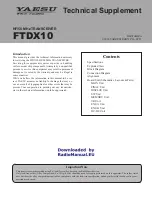
2121468.11 GB/D/F/E 02/2010
12
WIKA Operating instructions/Betriebsanleitung/Mode d'emploi/Instrucciones de servicio LS/LH-10
2121468.11 GB/D/F/E 02/2010
13
WIKA Operating instructions/Betriebsanleitung/Mode d'emploi/Instrucciones de servicio LS/LH-10
Order-No.
71 93 131
The optional filter element for self-mounting avoids the
ingress of pollution and water into the venting tube for the
pressure compensation to the atmosphere.
24 59 686
The optional cable box with weather protection IP 67 with
venting element (NEMA 4) is suitable for mounting outside
of the shafts and tanks or directly in dry control boxes.
20 74 257
For mechanical assembly of the level probe a cable strai-
ning clamp is optionally available.
15 24 399
In order to increase the mass of the level probe an additi-
onal mass (approx. 500 g = 1.1 lb.) can be screwed on.
Failure
Possible cause
Procedure
Signal span dropping off/too small
Diaphragm is damaged, e.g. through
impact, abrasive/agressive media;
corrosion of diaphragm/pressure
connector; transmission fluid missing.
Contact the manufacturer and replace
the instrument
Signal span drops off
Moisture present (e.g. at the cable tail) Install the cable correctly
Signal span erratic or incorrect
Working temperature too high/too low Ensure permissible temperatures as per
the Operating Instructions
Abnormal zero point signal
Medium or ambient temperature too
high/too low
Control the internal temperature of the
instrument within the permissible range;
observe the allowable temperature error
(see Operating Instructions)
Diaphragm is damaged, e.g. through
impact, abrasive/agressive media;
corrosion of diaphragm/pressure
connector.
Replace instrument
Working temperature too high/too low Ensure permissible temperatures as per
the Operating Instructions
Zero point signal unstable/ too low/high Moisture present (e.g. at the cable tail) Install the cable correctly,
filter element insertion
8. Maintenance, accessories
GB
9. Trouble shooting
GB
9. Trouble shooting
Do not insert any pointed or hard objects into the pressure port for cleaning to prevent
damage to the diaphragm.
Take precautions with regard to remaining media in removed pressure trans-
mitters. Remaining media in the pressure port may be hazardous or toxic!
Remove the pressure transmitter from service and mark it to prevent it from
being used again accidentally, if it becomes damaged or unsafe for opera-
tion.
Have repairs performed by the manufacturer only.
Please verify in advance if pressure is being applied (valves/ ball valve etc. open) and if the
right voltage supply and the right type of wiring (2-wire/ 3-wire/4-wire) has been chosen?
!
Warning








































